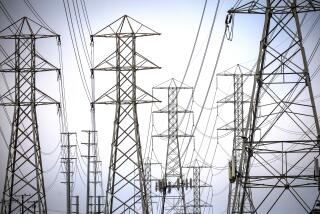State Switches On to High-Efficiency Lighting Program
WASHINGTON — The U.S. Environmental Protection Agency and the state of California Thursday entered a five-year energy conservation and pollution prevention pact expected to save more than $250 million through the use of high-technology, high-efficiency lights in state offices and facilities.
Signing a memorandum of understanding during a television hookup between Washington and Sacramento, EPA Administrator William K. Reilly and Gov. Pete Wilson hailed the agreement as a significant contribution to improving California air quality and a harbinger of relief for taxpayers.
By installing the modern lighting in about 70 million square feet of space, nearly all of the state’s buildings, Wilson said that California will see its electrical energy requirements reduced by more than 3 billion kilowatt hours over the period of the agreement, enough to power 167,500 homes.
According to EPA estimates, the reduced electrical consumption will prevent the emission of 400,000 pounds of sulfur dioxide, 1.3 million pounds of nitrogen oxides, and 422 million pounds of carbon dioxide each year. The carbon dixoide figure is equivalent to the yearly emissions of 38,000 automobiles.
California becomes the second state and the largest participant in the “green lights” program, begun last January when 23 corporations signed similar agreements with the federal environmental agency.
Maryland joined the program Wednesday, committing itself to putting state-of-the-art lighting equipment in 55 million square feet of state buildings and offices.
Under the pact signed by Reilly and Wilson, the state has agreed to review its lighting and to install the new technology where possible. At the end of five years, it will share data on the performance and the savings from the new lights with the EPA.
The state will also try to educate the public on the savings and benefits of efficient lighting technology and assist in recruiting private companies to join the program.
The federal agency will act in turn as an information clearing house, assisting in the selection of lighting options and economic and technological data on equipment. Although the early participants in the program are corporations, utilities and now states, EPA expects that their introduction of modern lighting eventually will dramatically reduce the price of lighting suitable for ordinary homes.
Estimates are that high-tech 75-watt bulbs now available will save an average of $80 in electrical consumption, since they last 10 times longer and use less than one-third the power of conventional incandescent bulbs. Although all of the major lighting manufacturers are producing the new products, the high-tech 75-watt bulb sells for about $15 to $18.
Even so, EPA officials said, there have been price reductions of 20% to 30% already.
Some utilities, including Southern California Edison, have launched programs to encourage customers to buy the new equipment, seeing massive conservation as a preferred alternative to constructing new power plants. The huge Southland utility has begun sending out $5 certificates, which its customers can use against the purchase of the new bulbs.
Since the green lights program was unveiled, about 160 corporations have joined in agreements with the EPA. Saying that he hopes to see the number of corporate partners reach 200 by the end of the year and 2,000 within the next few years, Reilly predicted that the program will see corporate executives lining up to join once there is widespread appreciation of the potential savings.
Despite the program’s growth, it is still run by a tiny bureaucracy within EPA. By any measure, Reilly said, it has already become one of the agency’s most successful efforts.
With full commercial and industrial participation, he estimated, the program could reduce the nation’s electricity demand by 10%. The resultant reduction in carbon dioxide emissions would equal one-third of the carbon dioxide output of all the nation’s automobiles.
Despite the early success in lining up industrial partners and the prospects of other states following California and Maryland, the federal government has passed up the opportunity to make the massive federal establishment itself a demonstration project.
The Bush Administration has brushed aside recommendations that modern lighting technology be used in federal buildings. It dropped from its national energy strategy a provision calling for the adoption of federal lighting efficiency standards.
But Reilly said that the EPA soon will have the equipment installed on one floor of its headquarters and expects to adopt it throughout a new EPA building that will be built.
The ‘Green Lights’ Program
California and the U.S. Environmental Protection Agency agreed on a five-year energy conservation and pollution prevention program, which promotes the use of high-tech, high-efficiency lights in state offices. Here is a look at some EPA recommendations: ITEM: Incandescent light bulb REPLACEMENT: Compact fluorescent bulb, which lasts much longer than common light bulbs
ITEM: Cool white fluorescent bulb REPLACEMENT: T-8 trichromatic lamp, which offers better color, uses less energy ITEM: Magnetic ballast, which regulates current to fluorescent lamps REPLACEMENT: Electronic ballast, which uses less electricity, reduces lamp flicker ITEM: Basic light switch REPLACEMENT: Occupancy sensor, which detects presence of people and turns lights on or off ITEM: Mercury vapor lamp, often used in street lighting REPLACEMENT: High-pressure sodium lamp, which provides more light at lower cost ITEM: Incandescent floodlight REPLACEMENT: Halogen floodlight, which uses less energy SOURCE: Environmental Protection Agency
More to Read
Sign up for Essential California
The most important California stories and recommendations in your inbox every morning.
You may occasionally receive promotional content from the Los Angeles Times.









